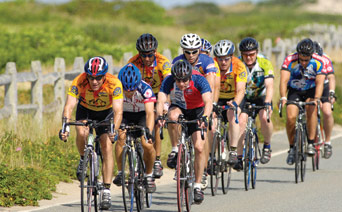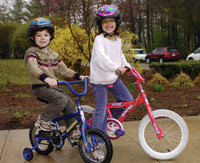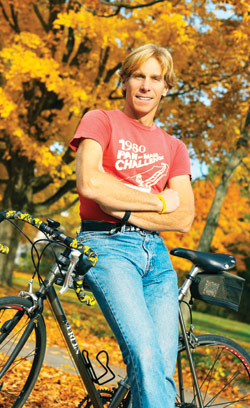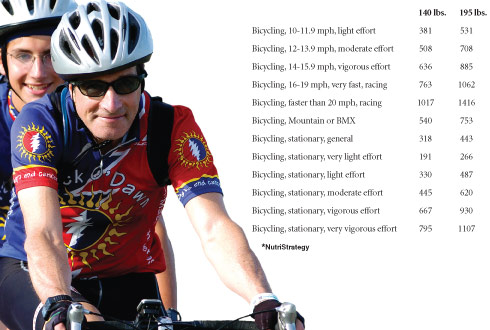Take A Ride
Cycling for your health, for others or just for the fun of it
By Cheryl Fenton
It would not be at all strange if history came to the conclusion that the perfection of the bicycle was the greatest incident of the 19th century. ~Author Unknown
 You face your nemesis head on with strength and determination. It won’t beat you. You won’t let it. Pumping and pumping, you climb the daunting hill. You reach the top—victory! Now the reward of your labor, wind in your hair, you coast down the other side. An exhilarating rush, faster and faster. You’re flying.
You face your nemesis head on with strength and determination. It won’t beat you. You won’t let it. Pumping and pumping, you climb the daunting hill. You reach the top—victory! Now the reward of your labor, wind in your hair, you coast down the other side. An exhilarating rush, faster and faster. You’re flying.
It’s a familiar scenario many have shared. Your first solo flight, dad’s reassuring hand quietly releasing the seat as you balance on your own. Then, decades later, logging a 40-mile ride through winding country roads with your own family. Cycling has traveled through all ages. In fact, more than 41.4 million Americans age seven and older are estimated to have ridden a bike six or more times, according to the National Sporting Goods Association.
As a heart-pumping, low-impact, body-friendly fun workout, it’s no wonder cycling is climbing the hill as one of the most popular recreations in the United States.
A Wheel Good Workout
“The American Heart Association recommends seven days a week of cardiovascular exercise, a minimum of 30 minutes every day. For most people, it’s too difficult to grasp that whole idea,” says Alex Klemmer, an avid cyclist. In February 2005, Klemmer and her brother, Bill Pryor, opened Wellesley’s Spynergy, a studio dedicated exclusively to indoor cycling, or spinning.
Cycling is a sneaky way to incorporate this overwhelming amount of exercise into your life—masking cardio and muscle training with a little adventure and travel.
“With outdoor cycling, it’s still exercise, but there’s a fun element to it,” says Pryor. “There’s a drudgery with going to the gym that cycling doesn’t have. You see things, it’s functional, you can go from point A to B.”
A bike is also the perfect way to ride down the road to fitness with less stress on your body. Riders enjoy a low impact, high aerobic workout that boosts endurance and builds strength (think back and legs, with less stress on knees). Depending on speed, terrain and the type of bike, you can say goodbye to 350 to 450 calories.
Cycling doesn’t forget the people on the fringe of fitness…those saddled with orthopedic problems or obesity issues. It’s even perfect for those enthusiasts who want to mix things up, fitting it in among running or tennis workouts.
Not to mention its accessibility. Very rarely does one find a workout that can help you check tasks off your to-do list. You can easily fit a bike ride into your busy day, combining exercise with errands—trips to the store, the bank, or the post office. You can even get fit during a vacation. Just rent a bike to see the sites more intimately than driving.
It’s this ease, low impact and versatility that has led to an upswing in the sport, according to Pryor.
 “Everyone’s talking about this phenomenon of baby boomers aging,” he says. “A lot of those people who were highly active in their younger years, with higher impact sports like basketball, running and tennis, have discovered cycling. It provides all the aerobic benefits without the trauma that happens with higher-impact sports.”
“Everyone’s talking about this phenomenon of baby boomers aging,” he says. “A lot of those people who were highly active in their younger years, with higher impact sports like basketball, running and tennis, have discovered cycling. It provides all the aerobic benefits without the trauma that happens with higher-impact sports.”
Pryor should know. After hitting the basketball courts three times a week for years, he was given a choice—a doctor-recommended prescription of low-impact exercise or a knee replacement at the age of 40. Pryor took the smart route and chose cycling.
“There are a lot of people out there in that situation,” he says. “They’re getting older and looking for something that isn’t as traumatic on the body.”
And the numbers don’t lie. Reaching more than $5.7 billion in sales in 2004, this industry is booming. According to the U.S. Bicycle Product Suppliers Association, in the first six months of 2004, U.S. suppliers shipped 3.6 percent more bikes to retailers than in 2003.
A Bicycle Built For You
Paul Segal, buyer/manager at International Cycle in Newton, suggests choosing a bike based on the type of riding in your future: distance; terrain; objectives; and, most importantly, what’s fun for you. A full range of bikes is available in each category, from standard to exotic.
“A well-designed bike will work well in the materials that the designer has chosen to execute the design in, whether it’s carbon fiber, aluminum, titanium or steel,” he continues.
Since the first bike in 19th century Europe (a wooden scooter-like contraption called a celerifere), its design has undergone many changes. Today there are over one billion bicycles in the world. Which type works for you?
Mountain—These are the most widely sold bikes. A strong and durable choice, they are designed to handle rough terrain such as gravel, dirt and grass. They boast a heavy-duty frame, flat handlebars, and thick tires (usually 2 to 2 ½ inches), and multiple gearing options.
Road—Used for pavement riding, these bikes have narrow tires (from 1 1/4 to 1 3/4 inches) and are about 26 to 27 inches in diameter. Road bikes usually come with downward curved or drop handlebars. They can have three or more gears; some actually have 30 gears. Low gears make riding uphill easier, and thus, more fun! Higher gears allow the rider to pedal productively while going downhill, so he or she can choose to coast or pedal to go even faster.
Hybrid—Hybrids are a cross between mountain and road bikes and are used for on- and off-road biking. Hybrid tires are thinner than mountain bike tires but fatter than road bikes (in the 1 3/4 to 2 inch range). The handlebars are usually straight as on a mountain bike, but the frame is structured differently. Hybrids are less rugged than mountain bikes, and they offer more comfort than the typical road bike.
Racing—This very lightweight bike has narrow, high-pressure tires (most just one-inch wide) and is designed for speed and success. Recreational bikers would find racing bikes to be less comfortable than the other options available.
Recumbent—Barnum & Bailey might have showcased these odd-looking bikes in their center ring. The rider leans back on a low seat with their legs stretching forward to the pedals. Bizarre or not, reclining bikes are great for riders who value comfort and less back stress.
How much will this hobby cost? You can spend in the low hundreds or in the high thousands on a bike. The selections are virtually limitless. Do some research to find an approximate range for your bike requirements.
Of course beyond the bike is the necessary gear that makes the trip not only more enjoyable, but safer.
Although there is no adult helmet law in the state of Massachusetts, it’s doesn’t take a genius to understand the need for headgear. As Segal warns, “You can’t grow another head.” For good safety, make sure your helmet is properly fitted and within its suggested lifespan (between three and six years, depending on the model).
“The second most important thing is padded riding shorts, either standard Lycra style racing or baggy style casual shorts with a built-in liner for cycling,” says Segal. “Cut-off blue jeans are the worst because they have a fat seam right at the pressure points.” He also suggests padded riding gloves to protect hands from road shock.
Indoor Vs. Outdoor
In an area of the country where sometimes Mother Nature isn’t always that kind to outdoor enthusiasts, cyclists are tempted to bring the outdoors in during the colder months.
Enter spinning – a pedal above the stationary bikes of yesteryear. Developed by an outdoor cyclist who tried to replicate the outdoor experience, a spinning bike closely resembles the positions and geometry of an outdoor bike. Riders simulate hill, rough terrain or declines…all with the twist of the knob. Classes are led by motivational instructors in a dark room, music blaring, so you can “travel” to new destinations in your mind.
Much more intense than its outdoor counterpart, spinning is designed to make you sweat. “What you would do in 50 minutes in spinning would be very different in an outdoor ride,” says Klemmer. “Outdoor is not usually as intense, it’s more gradual.”
But don’t let that scare you. These classes aren’t just for the great and powerful.
“You can modify the ride to where you want to go,” she explains. “It’s individual. As a beginner, you can enjoy it as much as the guy next to you who is riding the Pan Mass Challenge in three weeks and has been training for two years.”
If you choose to keep it a private love affair with cycling, trainers and rollers can help you avoid cycle hibernation during the cold months. Available at bike shops, they fit around your outdoor bike, turning it into a stationary bike. Now you can ride to your heart’s desire without leaving your home.
Whether it’s a music-motivated indoor session or an outdoor adventure, Pryor believes there’s more to cycling than meets the eye (and mind).
“There’s also a psychological or mental element to cycling,” explains Pryor. “For people who are stressed in their lives, cycling or spinning is the only place where you can’t be reached on your Blackberry. That hour of exercise you get a few times a week becomes a respite. It’s almost a form of meditation, where you can clear your mind. The mental health benefits are certainly real.”
Riding for Others
Aside from heart-healthy cardio, cycling touches hearts in other ways. This is how Wellesley resident Billy Starr saw things when he started the Pan-Massachusetts Challenge (PMC)—an annual bike ride that has become the leading athletic fund-raiser in the nation.
Before the PMC was a date circled on someone’s training calendar, Starr was just a bike enthusiast. A simple man who, for a few years in the ‘70s, rode a particular route “for kicks”—just a short jaunt between Newton and Provincetown to the tune of 120 miles.
“I would get up at 4 a.m. and bike to make the 3:30 ferry home. During this trip, a few things became clear,” he explains. “There was a spirit of adventure in the travel. There’s also a lot to learn about cycling—the endurance, the clothing, the weather, the nutrition, the neighborhoods, the streets you’re riding. These were all pieces of the puzzle that made the adventure worth sharing.”
Fueled by the loss of his mother and cousin to cancer in the late ‘70s, Starr then pushed forward with his desire to make a difference, using cycling as his route to helping others, specifically the Dana-Farber Cancer Institute and the Jimmy Fund.
“I was always of the belief that my life’s work needed to matter more than a paycheck,” he remembers. “I had a hard time settling for 9-to-5 work that was all about profit and working for a boss. I needed to do something on my own. I always believed I could make it grow and make it big. I dedicated myself to it.”
Dedicate himself he did. In 1981, the PMC was born. The original route took 210 riders 192 miles from Sturbridge to Provincetown and raised $40,600 for Dana-Farber. The group has reached amazing numbers. Last year saw 3,883 cyclists riding for the cause. And it’s still growing. To date, registration for the 2006 PMC to take place from August 5 -6, is already over 4,100 riders.
Grown too is the number of paths riders have available to them. Today’s cycling philanthropists have a choice of eight routes (four one-day rides, four two-day) that range from 70 miles to 192 miles.
Staying true to its mission of giving solely to Dana-Farber and the Jimmy Fund, the PMC has raised $145 million to date to help fight the good fight. With one of the starting points in Wellesley, the contributions of the town and its Weston neighbors are truly impressive. Together, 136 riders from these two towns contributed more than $1 million of the 2005 total $23 million.
Those who give keep on giving, according to Starr, with the PMC boasting a 70 percent retention rate. “The average number of years in the event is almost 5 years,” he says. “For every first-time rider, you’ve got someone who has been there seven or eight years. You won’t find that anywhere. The average [amount raised] is $6,000 a person. That’s a huge commitment.”
“The formula put forth with this event is all about empowering,” he continues. “This event doesn’t work if you don’t have your act together. Job, health, family…you need those three houses in order to be able to successfully involve yourself [with the PMC].”
Helping to get things in order for its riders, the PMC has recently teamed up with Fitcorp, one of America’s largest providers of fitness and worksite wellness services. Together they provide a comprehensive guide to training and nutrition created specifically for PMC cyclists to help them prepare for the event weekend.
Simple Pleasures
Regardless of the intricate workings of the muscles, the complexity of the machine or the cause of the ride, cycling is a simple delight. One found in your own backyard.
“Once you start riding, you discover unbelievable wonderful rural roads you didn’t know existed,” says Pryor. “On a good healthy bike ride, you might go 40 miles; whereas, if you spent the same amount of time running, you might only go six miles. You get a different exploration of your area with outdoor cycling.”
One local cycling group that continues to discover and share is the Charles River Wheelmen (CRW). They meet weekly for social rides in the Boston area, beginning from various locations on the North and South Shores and Metro West. With more than 1,200 members, there are enough riders of different abilities and interests to guarantee all levels and pace. (Check out their website, www.crw.org, for more information on rides.)
The Wellesley-Weston area is one of the favorites, according to Pryor, who has enjoyed a few CRW rides. “[That area] has some of the greatest riding anywhere around. There’s a nice rolling terrain that is perfect for cycling. You don’t want to have flat. It’s the coasting that makes it fun.”
Ah, coasting. It brings out the kid in all of us, wind on our face, not a care in the world.
“That’s the beautiful thing,” says Klemmer. “Most of us learned cycling as a small child. At any age, you can pick up a bike, get out there and go for it. If you get a bike as a gift, you can go out the next day and have an entire new aspect of your life open up that you forgot about since you were younger.”
Perhaps no one summed up this youthful freedom found on the seat of a cycle more plainly than beloved Bostonian John F. Kennedy—“Nothing compares to the simple pleasure of a bike ride.”
Cycling – Calories Burned Bike Riding per hour*

Cycling Forward
After losing their husbands to the 9/11 attacks, Needham’s Susan Retik and Wellesley’s Patti Quigley established Beyond the 11th to help provide financial and emotional support to widows in Afghanistan and their children, creating hope for a better future. Retik talked to WellesleyWeston about their efforts…
After September 11th, pregnant with my third child, I was overwhelmed by the support from friends, family, even strangers from around the world. As I began learning more about Afghanistan, I was shocked by the disparity between the compassion showed to me and the lack thereof for the widows in Afghanistan. I wanted to try to make a difference in their lives, as so many had done for me. Beyond the 11thwas established to help support widows in Afghanistan through income generation programs.
Cycling Forward, Beyond the 11th’s major fund-raiser, has raised about $320,000. In 2004, Patti Quigley (co-founder) and I rode our bikes from Ground Zero in New York City back to Boston. We were met by 200 other cyclists for the final 30 miles—each person representing one of the New Englanders killed on 9/11. In 2005, we had a group of people join us for the whole three-day 275-mile ride, with many more people riding the final 100 or 30 miles.
The organization’s mission is to help widows support themselves and their families – with an initial emphasis on Afghanistan. Our goal is to make grants to existing non-governmental organizations that will help widows learn a trade, receive basic education, have access to health care and gain proper shelter.
Patti and I had never done any cycling prior to organizing Cycling Forward. We’ve found that there’s an amazing community who cycles and we were excited to be a part of it.
We want people to have an opportunity to learn about the circumstances facing these widows and for the widows to learn more about us and know that we are there to support them. Together we can build a cycle of connection, compassion and peace for future generations to carry on.
This year’s Cycling Forward ride is September 8-10. For more information, visit www.beyondthe11th.org.
© 2006 Elm Bank Media



recent comments